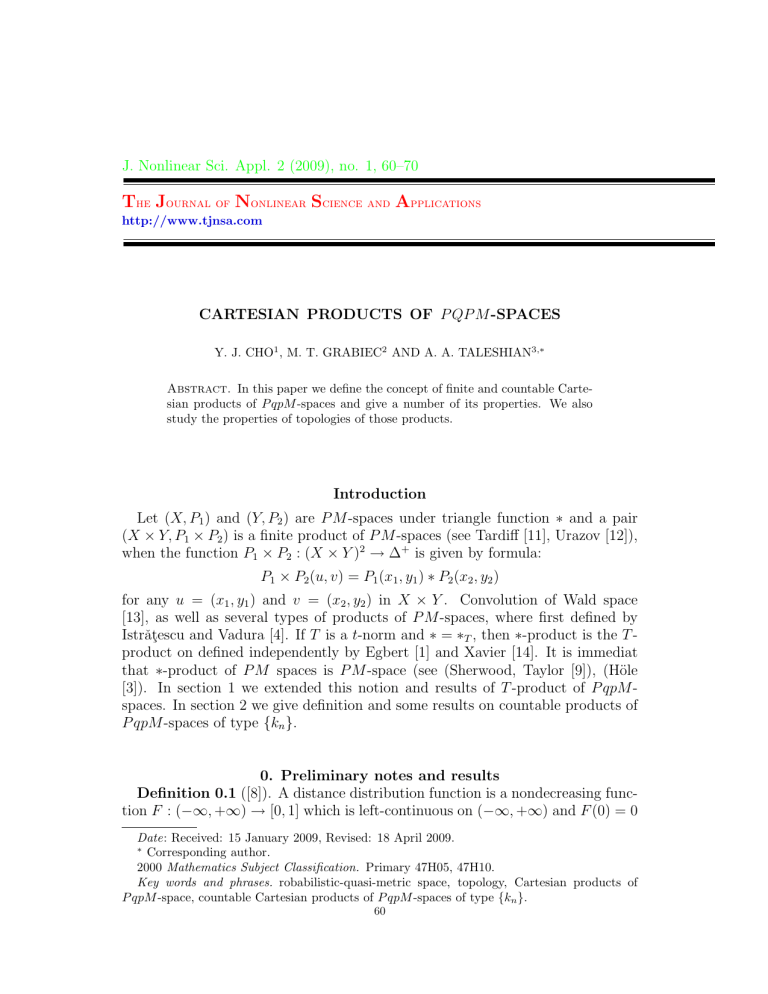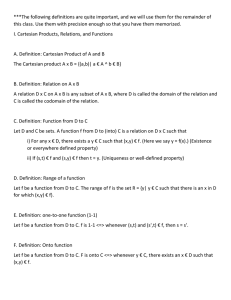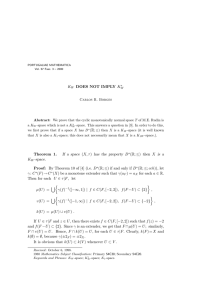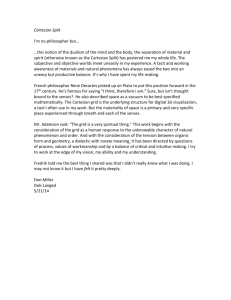T J N S
advertisement

J. Nonlinear Sci. Appl. 2 (2009), no. 1, 60–70
The Journal of Nonlinear Science and Applications
http://www.tjnsa.com
CARTESIAN PRODUCTS OF P QP M -SPACES
Y. J. CHO1 , M. T. GRABIEC2 AND A. A. TALESHIAN3,∗
Abstract. In this paper we define the concept of finite and countable Cartesian products of P qpM -spaces and give a number of its properties. We also
study the properties of topologies of those products.
Introduction
Let (X, P1 ) and (Y, P2 ) are P M -spaces under triangle function ∗ and a pair
(X × Y, P1 × P2 ) is a finite product of P M -spaces (see Tardiff [11], Urazov [12]),
when the function P1 × P2 : (X × Y )2 → ∆+ is given by formula:
P1 × P2 (u, v) = P1 (x1 , y1 ) ∗ P2 (x2 , y2 )
for any u = (x1 , y1 ) and v = (x2 , y2 ) in X × Y . Convolution of Wald space
[13], as well as several types of products of P M -spaces, where first defined by
Istrǎţescu and Vadura [4]. If T is a t-norm and ∗ = ∗T , then ∗-product is the T product on defined independently by Egbert [1] and Xavier [14]. It is immediat
that ∗-product of P M spaces is P M -space (see (Sherwood, Taylor [9]), (Höle
[3]). In section 1 we extended this notion and results of T -product of P qpM spaces. In section 2 we give definition and some results on countable products of
P qpM -spaces of type {kn }.
0. Preliminary notes and results
Definition 0.1 ([8]). A distance distribution function is a nondecreasing function F : (−∞, +∞) → [0, 1] which is left-continuous on (−∞, +∞) and F (0) = 0
Date: Received: 15 January 2009, Revised: 18 April 2009.
∗
Corresponding author.
2000 Mathematics Subject Classification. Primary 47H05, 47H10.
Key words and phrases. robabilistic-quasi-metric space, topology, Cartesian products of
P qpM -space, countable Cartesian products of P qpM -spaces of type {kn }.
60
CARTESIAN PRODUCTS OF P QP M -SPACES
61
and lim F (x) = 1. We denote by ∆+ the set of all distribution functions and by
x→∞
εa specific distribution function by
(
1, for t > a,
εa (t) =
0, for t ≤ a, a ∈ R.
The element of ∆+ are partially ordered by
F ≤ G if and only if F (x) ≤ G(x), for x ∈ R.
For eny F, G ∈ ∆+ and h ∈ (0, 1], let (F, G, h) denote the condition
G(x) = F (x + h) + h for all x ∈ (0, h−1 )
and
dL (F, G) = inf{h : both (F, G; h) and (G, F ; h) hold}.
As shown by Sibley [10] the function dL is a metric in ∆+ which is a modified
form on the well-known Levy metric for distribution functions and the metric
space (∆+ , dL ) is compact and hence complete (see [8, pp. 45-49]).
Definition 0.2 ([8,15]). A binary operation ∗ : ∆+ × ∆+ → ∆+ is a triangle
function if (∆+ , ∗) is an Abelian monoid with identity ε0 in ∆+ such that, for
any F, F 0 , G, G0 ∈ ∆+ ,
F ∗ G ≤ F 0 ∗ G0 whenever F ≤ F 0 , G ≤ G0 .
Note that a triangle function ∗ is continuous if it is continuous with respect to
the metric topology induced by dL .
Let T (∆+ ) denote the family of all triangle functions ∗ then the relation ≤
defined by
∗1 ≤ ∗2 ⇔ F ∗1 G ≤ F ∗2 G, for all F, G ∈ ∆+
(0.2.1)
is a partial order in the family T (∆+ ).
The second relation in the set T (∆+ ) is defined by
∗1 ∗2 ⇔ ((E ∗2 G) ∗1 (F ∗2 H)) ≥ ((E ∗1 F ) ∗2 (G ∗1 H)) ,
(0.2.2)
for all E, F, G, H ∈ ∆+ .
We can see the connection between the two relation: ∗1 ∗2 implies ∗1 ≥ ∗2
and following conditions: min ≥ ∗ and min ∗, for all ∗.
Definition 0.3 ([2]). A probabilistic-quasi-pseudo-metric-space (briefly, a P qpmetric space) is a triple (X, P, ∗), where X is a nonempty set, P is a function
from X × X into ∆+ , ∗ is a triangle function and the following conditions are
satisfied (the value of P at (x, y) in X 2 will be denoted by Pxy ):
Pxx = u0 , for all x ∈ X,
(0.3.1)
Pxy ∗ Pyz ≤ Pxz , for all x, y, z ∈ X.
(0.3.2)
If P satisfies also the additional condition
Pxy 6= ε0 it x 6= y,
then (X, P, ∗) is called a probabilistic quasi-metric space.
(0.3.3)
62
CHO, GRABIEC AND TALESHIAN
Moreover, if P satisfies the condition of symmetry:
Pxy = Pyz ,
then (X, P, ∗) is called a probabilistic metric spac (P M -space).
If the function Q : X 2 → ∆+ be defined by
Qxy = Pyx , for all x, y ∈ X,
(0.3.4)
then a triple (X, Q, ∗) is also a probabilistic-quasi-pseudo-metric space. We say
P and Q are conjugate each other.
Lemma 0.4. Let (X, P, Q, ∗) be a structure defined by P qp-metric P and
∗1 ∗ (0.2.2). Then (X, F ∗1 , ∗) is a probabilistic pseudo-metric space whenever
the function F ∗1 : X 2 → ∆+ is given by:
∗1
= Pxy ∗1 Qxy , for allx, y ∈ X0 .
Fxy
(0.4.1)
If additionally, P satisfies the condition
Pxy 6= u0 or Qxy 6= u0 for x 6= y,
(0.4.2)
then (X, F ∗1 , ∗) is a P M -space.
Lemma 0.5 ([2, Example 9]). If (X, p) is a quasi-pseudometric-space and the
function Pp : X 2 → ∆+ is defined by
Pp (x, y) = εp (x, y), for all x, y ∈ X
and ∗ is a triangle function such that
εa ∗ εb ≥ εa+b for all a, b ∈ R+ ,
then (X, Pp , ∗) is a proper P qp-metric space.
Theorem 0.6 ([2, Theorem 6]). Let (X, P, ∗) be a P qp-metric space under
a uniformly continuous t-function ∗ and, for any x ∈ X, and t > 0, the P neighborhood of x be a set
NxP (t) = {y ∈ X : dL (Pxy , u0 ) < t}.
Then the collection of all P -neighborhood form a base for the topology τP
on X the P qp-metric Q which is a conjugate of P generate a topology τQ on
X. Thus natural structure associated with a P qp-metric is a bitopological space
(X, τP , τQ ).
It is worthy of note that in the spaces (X, Pp , Qq , ∗), the τPp -topology is equivalent to the q-quasi-pseudometric topology τPq (see [2], [11]).
Lemma 0.7. Let (X, P, ∗) be a P qpM -space. Then the relation ≤P defined by
x ≤P y if and only if Pxy = ετ
(0.7.1)
is reflexive and transitive, i.e. it is a quasi-order on X.
Proof. Reflexivity follows immediately from (0.2.1) and transivites is a consequence of (0.3.2).
Corollary 0.8. If P qp-metric satisfies the assumption (0.4.2), then the relation ≤P is a partial ordering on X.
CARTESIAN PRODUCTS OF P QP M -SPACES
63
Proof. Assume that x ≤P y and y ≤P x. This means that
Pxy = ε0 and Pyx = u.
By (0.4.2), it follows that Pxy = Pyx = ε0 if and only if x = y.
Corollary 0.9. If x 6= y imply Pxy = ε0 and Pyx 6= ε0 or Pxy 6= ε0 and
Pyx = ε0 , then ≤P is a linear ordering on X.
Remark 0.10. If Q is a conjugate of a P qp-metric P , then the relation ≤Q
generated by Q is also a quasi-ordering on X and is the inverse relation of ≤P .
1. Cartesian products of PqpM -spaces
In this section, we give some properties of Cartesian products of P qpM -spaces.
Definition 1.1. Let (X, P1 , ∗) and (Y, P2 , ∗) be P qpM -spaces. The ∗-product
of (X, P1 ) and (Y, P2 ) is the pair (X × Y, P1 × P2 ), where P1 × P2 is the function
from (X × Y )2 into ∆+ given by
P1 × P2 (u, v) = P1 (x1 , y1 ) ∗ P2 (x2 , y2 )
(1.1)
for any u = (x1 , y1 ) and v = (x2 , y2 ) in X × Y .
Theorem 1.2. Let (X, P1 , ∗) and (X, P2 , ∗) be P qpM -spaces. Let a mapping
P1 × P2 : (X × Y )2 → ∆+ be given by
P1 × P2 (u, v) = (P1 (x1 , x2 ) ∗1 P2 (y1 , y2 )) with ∗1 ∗
(1.2)
for any u = (x1 , y1 ), v = (x2 , y2 ) ∈ X × Y . Then (X × Y, P1 × P2 , ∗) is a
P qpM -space.
Proof. If u = v, then x1 = x2 and y1 = y2 . Thus, by (0.6.1), we have
P1 × P2 (u, v) = P1 (x1 , x1 ) ∗1 P2 (y1 , y1 ) = u0 ∗1 u0 = u0 .
Now, let w = (x3 , y3 ) X × Y . Then, by (0.3.2) and (0.2.2), we obtain
P1 × P2 (u, v) = P1 (x1 , x2 ) ∗1 P2 (y1 , y2 )
≥ (P1 (x1 , x3 ) ∗ P1 (x3 , x2 )) ∗1 (P2 (y1 , y3 ) ∗ P2 (y3 , y2 ))
≥ (P1 (x1 , x3 ) ∗1 P2 (y1 , y3 )) ∗ ((P1 (x3 , x2 ) ∗1 P2 (y3 , y2 ))
= P1 × P2 (u, v) ∗ P1 × P2 (w, v).
This completes the proof.
Definition 1.3. Let (X, P1 , ∗) and (X, P2 , ∗) be P qpM -spaces and let
∗1 ∗. Then (X ×Y, P1 ×P2 , ∗1 ) is called a Cartesian ∗1 -product of P qpM -spaces
provided that P1 × P2 is given by the formula (1.1).
By Definition 0.2 and (0.2.2), it follows that Min ∗ holds true for any t∆+ norm ∗. Thus it follows that the function given by
P1 × P2 (u, v) =Min (P1 (x1 , x2 ), P2 (y1 , y2 ))
= P1 (x1 , x2 ) × P2 (y1 , y2 )
satisfies the conditions of Theorem 1.2.
64
CHO, GRABIEC AND TALESHIAN
Theorem 1.4. Let (X, Gp1 , ∗M ) and (Y, Gp2 , ∗M ) be a P qpM -space defined by
t
formula Gp (x, y) = G p(x,y)
, where G ∈ ∆+ be distinct from ε0 and ε∞ , which
were generated by quasi-pseudo-metric p1 and p2 , respectively. Let a function
p1 ∨ p2 (X × Y )2 → R+ be defined by
p1 ∨ p2 (u, v) =Max (p1 (x1 , x2 ), p2 (y1 , y2 )),
where u = (x1 , x2 ) and v = (y1 , y2 ) belong to X × Y . Then the triple (X ×
Y, Gp1 ∨p2 , ∗M ) is a P qpM -space generated by a quasi-pseudo-metric p1 ∨ p2 .
As a consequence of Theorem 1.2, we have the following:
Corollary 1.5. Let (X, P, ∗) be a P qpM -space. Let ∗1 =Min. Then there are
four P qp-metrics on X × X generated by the function P , that is, P × P, P ×
Q, Q × P and Q × Q, where Q is the P qp-metric conjugate with P .
Remark 1.6. Note that, by Definition 1.1, for all u, v ∈ X × X, the following
equalities hold:
P × P (v, u) = Q × Q(u, v),
P × Q(v, u) = Q × P (u, v).
Therefore, the pairs P ×P and Q×Q as well as P ×Q and Q×P are the mutually
conjugate P qp-metrics defined on X × X. The function M (X × Y )2 → ∆+ given
by
M (u, v) = P × Q(u, v) ∧ Q × P (u, v) = P × P (u, v) ∧ Q × Q(u, v)
for all (u, v) ∈ X × X is a probabilistic pseudo-metric on X × X.
Corollary 1.7. Let (X, P, ∗) be a P qpM -space. Let the t∆+ -norm ∗ be continuous at (ε0 , ε0 ) and ∗1 =Min. Then the topology TP ×P generated by the function
P × P is equivalent to the topology TP × TP . Also, the topologies TP × TQ and
TP ×Q , TQ × TQ and TP ×Q , and TQ × TQ and TQ×Q are equivalent.
Proof. For an illustration, we prove the first equivalence. Let t1 , t2 > 0 and
x, y ∈ X. Then we have
NxP (t1 ) × NyP (t2 ) ∈ TP × TP .
Let t3 = max(t1 , t2 ) and u = (x, y) ∈ X × X. Then a P × P -neighbourhood of a
point u ∈ X × X is of the form:
NuP ×P (t3 ) = {v = (x1 , x2 ) P × P (u, v)(t3 ) > 1 − t3 }
= {v = (x1 , x2 ) Pxx1 (t3 ) > 1 − t3 and Pyy1 (t3 ) > 1 − t3 },
NxP (t3 ) × NyP (t3 ) ⊂ NxP (t1 ) × NyP (t2 ).
On the other hand, for each t > 0 and u = (x, y) ∈ X × X, we have
NuP ×P (t) = NxP (t) × NyP (t).
The remaining cases can be verified similarly. This completes the proof.
Theorem 1.8. Let (X, P, ∗) be a P qpM -space. Assume that the t∆+ -norm
∗ is continuous and let ≤P be the quasi-order generated by P (in the sense of
Lemma 0.7). Then the set G(≤P ) = {(x, y) ∈ X 2 x ≤P y} is closed in the
topology TP ×Q .
CARTESIAN PRODUCTS OF P QP M -SPACES
65
Proof. Assume that (x1 , y1 ) belongs to the P × Q-closure of G(≤P ) and does
not belong to G(≤P ). Then, by Corollary 0.9, Px1 y1 6= ε0 and there exists a
sequence {(xn , yn )} of G(≤P ) which is P × Q-convergent to (x1 , y1 ). This means
that
Px1 xn → ε0 , Qy1 yn → ε0 .
Thus, by (0.3.2), we have
ε0 6= Px1 y1 ≥ Px1 xn ∗ Pxn y1 ≥ px1 xn ∗ Pxn yn ∗ Pyn y1
= Px1 xn ∗ Pxn yn ∗ Qy1 yn
= Px1 xn ∗ ε0 ∗ Qy1 yn
= Px1 xn ∗ Qy1 yn → ε0 ,
which is a contradiction. This completes the proof.
Lemma 1.9. Let (X, P, ∗) be a P qpM -space satisfying the condition (0.3.4),
and let the t∆∗ -norm ∗ be continuous. Then the set
(←, x] = {y ∈ X y ≤P x},
where ≤P is the order generated by P , is a subset of NxQ (t) for every t > 0.
Proof. If y ∈ (←, x], then y ≤P x and so, by (0.3.4), we have
Pyx = Qxy = ε0 .
Therefore, we have y ∈
NxQ (t)
for every t > 0.
Corollary 1.10. The set (←, x] is Gδ in the topology TQ .
Proof. For t > 0, there is a natural number n such that
1
n
< t. Then we have
1
1
Qxy (t) ≥ Qxy ( ) > 1 − > 1 − t,
n
n
which means that
1
NxQ ( ) ⊂ NxQ (t).
n
Therefore, we conclude that the family {NxQ ( n1 )}n∈N satisfies the assertion. This
completes the proof.
Lemma 1.11. The set (←, x] is P -closed.
Proof. Assume that y belongs to the P -closure of (←, x] and y 6∈ (←, x]. Then
Pyx 6= ε0 and, for each n ∈ N, there is xn ∈ (←, x] such that
Pyxn → ε0 .
Finally, we have
ε0 6= Pyx ≥ Pyxn ∗ Pxn y = Pyxn ∗ ε0 = Pyxn → ε0 ,
which is a contradiction. This completes the proof.
Corollary 1.12. The set [x, →) = {y ∈ X x ≤P y} is a Q-closed and Gδ in
the topology TP .
The following result is an immediate consequence of Lemma 1.2:
66
CHO, GRABIEC AND TALESHIAN
Theorem 1.13. Let (X, P, ∗) be a P qpM -space satisfying the condition of
Corollary 0.9 and let the t∆+ -norm ∗ be continuous. Then the family {(←, x]}x∈X
forms
a
P -closed subbase of a topology, which is denoted by T (←]. Similarly, the family
{[x, →)}x∈X forms a Q-closed subbase of T [→).
We note that these families form, respectively, a P -closed and Q-closed base
and that the function P generates such a partial order ≤P in X which is a lattice
order.
Lemma 1.14. Let (X, P, ∗) be a P qpM -space satisfying the condition of Corollary 0.9 and let the t∆+ -norm ∗ be continuous. Then the set (←, x) = {y ∈ Xy <P
x} is Q-open and the set (x, →) = {y ∈ X x <P y} is P -open.
Proof. By Corollary 0.9, it follows that ≤P orders X linearly. Hence we have
(←, x) ⊂ NxQ (t) for all t > 0. On the other hand, for each y ∈ (←, x), we have
Qxy 6= ε0 . This means that there exists t > 0 such that
Qyx (t) > 1 − t.
We thus have NyQ (t) ⊂ (←, x). This completes the proof.
Corollary 1.15. Let (X, P, ∗) be a P qpM -space satisfying the condition of
Corollary 0.2 and let the t∆+ -norm ∗ be continuous. The family {(←, x)}x∈X is
a Q-open base for TQ . Similarly, the family {(x, →)}x∈X is a P -open base for the
topology TP .
Theorem 1.16. Let (X, P, ∗) be a P qpM -space. Then the family
{(←, x]}x∈X is a complete neighbourhood system in the space X. It thus defines
some topology on X. Similarly, {[x, →)}x∈X forms a complete neighbourhood
system in X.
Proof. It suffices to observe that, for each x ∈ X, x ∈ (←, x] and, if y ∈ (←, x],
then we have
(←, y] ⊂ (←, x].
2. Cartesian product in PqpM -spaces of the type {kn }
The following result characterizes countable Cartesian products of P qpM spaces.
Definition 2.1. Let {(Xn , Pn )} be a sequence of P qpMP
-spaces and let the
sequence {kn } of nonnegative numbers satisfy the condition n∈N kn = 1. Then
the pair
Q (X, P ) is called a Cartesian product of P qpM -spaces of the type {kn } if
X = n∈N Xn and P : X 2 → ∆+ is given by
X
Pxy =
kn Pn (xn , yn ),
(2.1)
n∈N
where x = {xn } and y = {yn }.
Definition 2.2 ([5]). A function T : I 2 → I (I = h0, 1i) is called a t-norm if
it satisfies the following conditions
CARTESIAN PRODUCTS OF P QP M -SPACES
(T1)
(T2)
(T3)
(T4)
(TA)
67
T (a, b) = T (b, a)
T (a, b) ≤ T (c, d) whenever a ≤ c and ≤ d
T (a, 1) = a
T (T (a, b), c) = T (a, T (b, c)), for all a, b, c, d ∈ I.
The t-norm T is said to be Archimedean if for any x, y ∈ (0, 1), there
exists n ∈ N such that
xn < y, that is xn ≤ y and xn 6= y,
where x0 = 1, x1 = x and xn+1 = T (xn , x), for all n ≥ 1. We shall now
establish the notation related to a few most important t-norm:
M (x, y) =Min (x, y),
Π(x, y) = x · y,
W (x, y) =Max (x + y − 1, 0).
(TM)
(TΠ)
(TW)
The function W is continuous and Archimedean and we give the following relations among t-norms
M ≥ Π ≥ W.
(TR)
Definition 2.3. Let X be a nonempty set, P : X 2 → D, and I in TI -norm. The
triple (X, P, T ) is called a quasi-pseudo-Menger space if it satisfies the axioms:
(M1) Pxx = ε0 , x ∈ X,
(M2) Pxz (t1 + t2 ) ≥ T (Pxy (t1 ), Pyz (t2 )), for all x, y, z ∈ X and t1 , t2 > 0.
If P satisfies also the additional condition:
(M3) Pxy 6= ε0 if x 6= y, then (X, P, T ) is quasi-Menger space.
Moreover, if P satisfies the condition of symmetry Pxy = Pyx , then (X, P, T ) is
called a Menger-space (see [5]).
Definition 2.4. Let (X, P, T ) be a probabilistic quasi-Menger space (P qM )
and the function Q : X 2 → D be defined by
Qxy = Pyx , for all x, y ∈ X.
Then the ordered triple (X, Q, T ) is also P qM -space. The function Q is called a
conjugate P qp-metric of the P . By (X, P, Q, T ) we denote the structure generated
by the P qp-metric P on X.
Lemma 2.5. Let (Xn , Pn ) be a sequence of proper P qpM -spaces (Lemma 0.5).
Then the Cartesian product (X, P ) of the type {kn } is also a proper P qpM -space.
Also, if each (Xn , Pn ) is a quasi-pseudo-Menger space with respect to the tI norm of type (T A), then so is the Cartesian product of type {kn }. Moreover, the
topology Tp of a Cartesian product of the type {kn } generated by P is equivalent
to the product topology.
Proof. For proper P qpM -spaces, the condition F ≥ ua is equivalent to the
statement that F (a+) = 1. It thus suffices to observe that, if, for some a > 0,
Pxn yn (a+) = 1
68
CHO, GRABIEC AND TALESHIAN
for all xn , yn ∈ Xn , then, by (2.1), we obtain
Pxy (a+) = lim(Σkn Pxn yn (t)) = Σkn = 1.
t→a
To prove the second part of the theorem, let us observe that, by the definition
of the tI -norm W and the Menger condition (M2), the following holds:
W (Pxz (t), Pzy (s)) =Max (Σkn Pn (xn , zn )(t) + Σkn Pn (zn , yn )(s) − 1, 0)
=Max ((Σkn (Pn (xn , zn )(t) + Pn (zn ,n )(s) − 1, 0)
≤Max ((Σkn Max (Pn (xn , zn )(t) + Pn (zn , yn )(s) − 1, 0), 0)
= Σkn W (Pn (xn , zn )(t), Pn (zn , yn )(s)
≤ Σkn Pn (xn , yn )(t + s) = Pxy (t + s).
Therefore, we have proved that the Cartesian product of the type {kn } is a quasipseudo-Menger space.
In order to prove the third assertion, let us suppose that the sequence {xn } is
P -convergent to x = {xk } in (X, P ). Then, for each t > 0, there exists n0 ∈ N
such that
xn ∈ NxP (t)
for all n > n0 . Suppose, further, that, for some i0 ∈ N, the sequence {xni0 } is not
convergent to xi0 ∈ Xi0 which is the i0 -th coordinate of x. This means that, for
some t0 > 0, there exists mn > n for all n such that
n
Pi (xi0 , xm
i0 )(t0 ) > 1 − t0 .
Let t = ki0 t0 . Then, for all n > n0 , we get
1 − t = 1 − ki0 t0
< Pxx mn (t)
X
n
=
ki Pi (xi , xm
i )(t)
i∈N
≤
X
ki0 + (1 − t0 )
i=i0
= 1 − ki0 + ki0 − ki0 t0
= 1 − t,
which is a contradiction. This means that, if {xn } is P -converegent, then each
sequence {xi } is Pi -convergent to xi for all i ∈ N. Thus the projections onto the
i-th coordinate are continuous. Therefore, the topology of the Cartesian product
of the type {kn } is stronger than the product topology.
Now, let U be a P -open set of TP . Then, if x ∈ U , there exists a P neighbourhood NxP (t0 ) ⊂ U . Let F ⊂ N be a finite subset such that
X
kj − (1 − t0 ) > 0.
j∈F
CARTESIAN PRODUCTS OF P QP M -SPACES
69
P
P
For every j ∈ F , we selsct yj ∈ Nxjj (t0 ) and fix t = 1−(1−t0 )( j∈F kj )−1 . Then,
for each y = {yj } such that yi = yj for i = j. where j ∈ F , we get
X
Pxy (t0 ) =
ki Pi (xj , yj )(t0 )
i∈N
>
X
kj Pj (xj , yj )(t0 )
j∈F
>
X
kj (1 − t)
j∈F
= 1 − t0 .
Thus it follows that y ∈ NxP (t0 ). Let Ui be Pi -open with Ui = Xi for i ∈ N − F
and Ui = NxPii (t) for i ∈ F . Then we have
Y
x∈
Ui ⊂ U,
i∈N
which shows that U is open in the product topology. This completes the proof.
Corollary 2.6. Each finite or countable Cartesian product of quasi-pseudometrizable spaces is quasi-pseudo-metrizable.
Proof. By Lemma 2.5, it follows that each finite or countable cartesian product
of quasi-pseudo-Menger spaces is a quasi-pseudo-Menger space with uspect to
the t-norm W . Since that sup{W (x, x) : x < 1} = 1 the topology of it is
quasi-pseudo-metrizable (see [6], [7]). Indeed, let p be a quasi-pseudo-metric
that generates the topology. Then (X, Gp ) of Theorem 1.4 satisfies the required
condition.
Remark 2.7. We note that the Cartesian products of P M -space were studied
by Istratescu and Vadura [4], Egbert [1], Sherwood and Taylor [9] and Radu [6].
References
[1] R.J. Egbert, Products and quotients of PMS, Pacific J. Math., 241 (1968), 437–455.
[2] M. Grabiec, Probabilistic quasi-pseudo-metric-spaces. Busefal, 45(1991), 137–145.
[3] U. Höhle, Probabilistiche Metriken auf der Menge der nichtnegativen Verteilungsfunctionen. Aequtiones Math., 18(1978), 345–356.
[4] V.I. Istrăţescu and I. Vădura, Products of statistical metric spaces. Stud. Cerc. Math.,
12(1961), 567–574.
[5] K. Menger, Statistical spaces. Proc. Acad. Sci. USA, 28(1942), 535–537.
[6] V. Radu, On probabilistic structures on product spaces. Proc. 5th Conf. Probability
Theory, Braşov (1974), 277–282.
[7] B. Schweizer, A. Sklar and E. Thorp, The metrization of statistical metric spaces, Pacific
J. Math. 10 (1960), 673–675.
[8] B. Schweizer and A. Sklar, Probabilistic Metric Spaces, North Holland, 1983.
[9] H. Sherwood and M.D. Taylor, Some PM structures on the set of distribution function.
Rev. Roumaine Math. Pures Appl., 19(1974), 1251–1260.
70
CHO, GRABIEC AND TALESHIAN
[10] D.A. Sibley, A metric for a weak convergence of distribution functions. Rocky Moutain J.
Math., 1(1971), 427–430.
[11] R.M. Tardiff, Topologies for probabilistic metric spaces. Pacific J. Math., 659(1976), 233–
251.
[12] V.K. Urazov, On products of probabilistic metric spaces, Vestnik Kazan. Univ. Mat. 4
(1968), 15–18.
[13] A. Wald, On a statistical generalization of metric spaces. Proc. Nat. Acad. USA, 29(1943),
196–197.
[14] A.F.S. Xavier, On the product of probabilistic metric spaces, Portugal. Math. 27(1968),
137–147.
[15] S. Shakeri, A contraction thorem in Menger probabilistic metric spaces, J. Nonlinear Sci.
Appl., 1 (2008), 189–193.
1
Department of Mathematics, Gyeongsang National University, Chinju 660701, Korea
E-mail address: yjcho@nongae.gsnu.ac.kr
2
Department of Operation Research, Academy of Economics, al. Niepodleglości 10, 60-967 Poznań, Poland
E-mail address: m.grabiec@ae.poznan.pl
3
Department of Mathematics, Faculty of Basic Sciences, University of Mazandaran, Babolsar 47416 − 1468, Iran.





